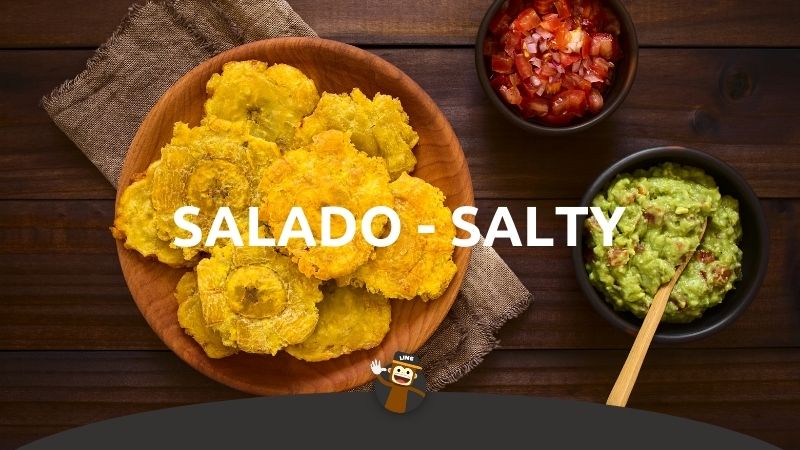Are you a foodie learning Spanish? It’s your lucky day! Today, we will learn about spicy, salty, sweet, sour flavors, and more! Your mouth will water as you learn how to describe flavors in Spanish. I will also show you some delicious dishes that we eat in Spanish-speaking countries.
When you travel through Spanish-speaking countries, you will surely come across many special flavors, perhaps unique, that you have never tried before.
Some people may be impressed to learn that there are rare foods in Latin America. Suitable only for the strongest stomachs and brave people. Like the dish made of coagulated lamb blood of the Mapuche people of Chile, the roasted ‘Cuy’ (guinea pig) in Ecuador, Peru, and Bolivia, the tacos with insects in Mexico, or the worm skewers in the Ecuadorian Amazon.
And do you know what the best thing about traveling and seeing the world is? It’s being able to try all those flavors that exist! Even if you end up not liking them, you can at least have a memory that you tried something that your friends might never try.
To enhance that incredible cultural and gastronomic experience, you can easily describe what you taste with Spanish vocabulary.
Therefore, this guide will help you understand the essential words you can use to describe flavors in Spanish. For example, if a taste seems too bitter, too sweet, or too delicious, you will be able to express everything. You wouldn’t even need to ask someone for help to translate from your native language.
So, let’s start with the most basic information. How to say the word ‘flavor’ in Spanish?
What Is The Spanish Word For ‘Flavor’?
‘The Flavor’ in Spanish is ‘El Sabor.’ If you want to talk about many flavors, change the word to its plural form, ‘Los Sabores.’ It is a noun, but it can also be a verb, ‘saber.’
When used as a verb: ‘Esto sabe mal.’ (This tastes bad.)
When used as a noun: ‘El sabor de esta sopa me gusta.’ (I like the taste of this soup.)
‘Sabor’, can also mean taste, and another Spanish word for it is ‘gusto.’
How To Say ‘Delicious’ In Spanish
It’s impossible to live without being able to describe the flavor of our food. Taste and flavors are the experiences we get while tasting a dish. It is also why people accept and choose one food or another, depending on their preferences.
We unconsciously describe tastes and flavors every day in our native language. In that case, we should also master some valuable words in the language that we are learning. You can use the following terms to say that something was delicious:
Lleno de sabor: Full of flavor
Se hace agua la boca: Mouthwatering
Rico: Delicious (A very common term)
Deli: Delicious (A slang term used when people don’t want to finish saying ‘delicioso’)

How Do You Describe Flavors?
Now, to describe the taste, you can use the term ‘sabe.’ After learning a few adjectives, you will be able to say if something tastes good, bad, and more.
Let’s continue learning more Spanish vocabulary!
The Distinct Flavors In Spanish
Negative Words About Flavor
Insípido: Tasteless, bland, flat, insipid
Sin Sabor: Flavorless or tasteless
Asqueroso: Disgusting (Never say this about the food in front of others in South America! It’s considered rude)

More Vocabulary Related To Taste And Flavors In Spanish
Learn a little about the most common words that those of us who speak Spanish use daily to describe the flavors of food, the way of cooking, and other related topics.
Condimentar: Flavor or spice up
Degustar, catar, probar: To taste (something)
De sabor fuerte: Strong flavored
Describing Different Tastes Of Mouthwatering Dishes

Salado (Salty)
La comida salada que más me gusta son los patacones.
(The salty food that I like the most are the patacones.)
Agrio (Sour)
El sabor agrio del ceviche peruano me encanta.
(I love the sour taste of Peruvian ceviche.)
Picante (Spicy)
La enchilada es demasiado picante!
(The enchilada is too spicy!)
Dulce (Sweet)
El pastel de mil hojas es dulce
(The thousand leaf cake is sweet.)
Amargo (Bitter)
¿Sabías que las alcachofas son de sabor amargo?
(Did you know that artichokes have a bitter taste?)
Agridulce (Sweet And Sour)
La mermelada de Butiá es de sabor agridulce
(Butiá jam has a bittersweet flavor.)
Time To Practice This Vocabulary In More Elaborate Sentences
After you have learned some useful vocabulary, you will be able to apply it in daily life sentences to describe tastes in Spanish.
If your level of Spanish is advanced enough to be able to create your sentences, try replicating the following examples to practice with your friends.
- Sé que están cocinando, ya que huelo un aroma sabroso que viene de la cocina. (I know they are cooking as I smell a savory aroma coming from the kitchen.)
- ¡Las sopas que cocina mi madre son las más deliciosas! (The soups that my mother cooks are the most delicious!)
- ¡El jamón serrano estuvo apetitoso! (The Serrano ham was appetizing!)
- Si la fruta es muy dulce, no me gusta. (If the fruit is too sweet, I don’t like it.)
- El aguacate está demasiado salado. (The avocado is too salty.)
- El wasabi tiene un sabor fuerte. (Wasabi has a strong flavor.)
- Me encanta el queso es de sabor fuerte. (I love a strong flavored cheese.)
- El limón es demasiado agrio. (The lemon is too sour.)
- La comida mexicana es demasiado picante para mi gusto. (Mexican food is too spicy for my taste.)
- El café está demasiado amargo, necesita más azúcar. (The coffee is too bitter, it needs more sugar.)
- Lo que estás comiendo huele muy bien, ¡y debe saber rico! (What you are eating smells great, and it must taste good!)
- Este platillo de carne sabe mal. (This meat dish tastes bad.)
- El arroz no tiene sabor. (The rice has no flavor.)
Ling Is Everything You Need To Learn Spanish
¡Writing about food always makes me hungry! Now I’m craving the most ‘dulce’ and ’empalagoso’ pastel de chocolate (sweet and gooey chocolate cake).
If you are learning Spanish, you are well on your way to making your experience in countries that speak the language much more pleasant and easy. Talking to people in their native language will make your journey much more enjoyable.
Establishing deeper bonds with people in their countries makes the experience valuable. A Spanish native speaker will be overjoyed to hear you make efforts to speak like a local.
Ling App can help you achieve fluency in speaking with natives without restraint. If books are not for you, why not take the chance to try learning Spanish vocabulary with a fun and motivational app? It can make your learning process easy and engaging!
So, if you are ready to taste different flavors around Spain or Latin America, get prepared with some helpful vocabulary to enhance your trip!
If you enjoyed this blog, why not check out some more of my personal favorites including cheers in Spanish and Spanish slang words.
Download Ling App and have it everywhere you go!









